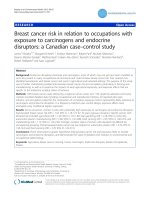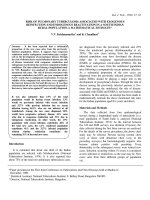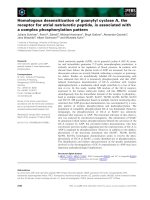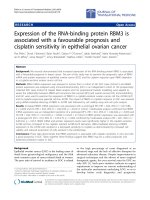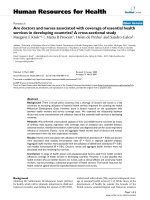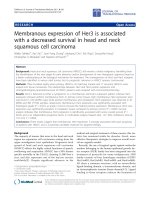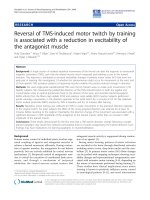LncRNA MEG3 rs3087918 was associated with a decreased breast cancer risk in a Chinese population: A case-control study
Bạn đang xem bản rút gọn của tài liệu. Xem và tải ngay bản đầy đủ của tài liệu tại đây (700.88 KB, 8 trang )
Zheng et al. BMC Cancer
(2020) 20:659
/>
RESEARCH ARTICLE
Open Access
LncRNA MEG3 rs3087918 was associated
with a decreased breast cancer risk in a
Chinese population: a case-control study
Yi Zheng1,2†, Meng Wang3†, Shuqian Wang2†, Peng Xu3, Yujiao Deng1,2, Shuai Lin3, Na Li1,2, Kang Liu4,
Yuyao Zhu1,2, Zhen Zhai1,2, Ying Wu1,2, Zhijun Dai2,3* and Gaixia Zhu1*
Abstract
Background: LncRNA MEG3 expressed abnormally in various cancers including breast cancer, but no studies
reported the correlation between MEG3 SNPs and breast cancer susceptibility among Chinese women.
Methods: This study is aimed to explore the association between three SNPs of MEG3 (rs3087918, rs7158663,
rs11160608) and breast cancer. The study is a population-based case-control study including 434 breast cancer
patients and 700 healthy controls. Genotyping was performed using Sequenom MassArray technique. Function
prediction of rs3087918 were based on RNAfold and lncRNASNP2 databases.
Results: Pooled analysis indicated that rs3087918 was related to a decreased risk of breast cancer [GG vs. TT: OR
(95%) = 0.67(0.45–0.99), P = 0.042; GG vs. TT + TG: OR (95%) = 0.69(0.48–0.99), P = 0.046], especially for women aged
<=49 [GG vs. TT: OR (95%) = 0.40(0.22–0.73), P = 0.02]. Comparison between case groups showed genotype GG and
TG/GG of rs3087918 were associated with her-2 receptor expression [GG vs. TT: OR (95%) = 2.37(1.24–4.63), P = 0.010;
TG + GG vs. TT: OR (95%) = 1.50(1.01–2.24), P = 0.045]. We didn’t find statistical significance for rs11160608, rs7158663
and breast cancer. Structure prediction based on RNAfold found rs3087918 may influence the secondary structure
of MEG3. The results based on lncRNASNP2 indicated that rs3087918 may gain the targets of hsa-miR-1203 to
MEG3, while loss the target of hsa-miR-139-3p and hsa-miR-5091 to MEG3.
Conclusions: MEG3 rs3087918 was associated with a decreased risk of breast cancer. MEG3 haplotype TCG may
increase the risk of breast cancer.
Keywords: MEG3, SNP, Breast cancer, Case-control study, miRNA
Background
Breast cancer (BC) is a serious threat to women’s health.
According to American cancer statistics 2020 [1], there
will be an estimated 276,480 new BC cases and 42,170
BC related death in 2020. For females, BC is the most
* Correspondence: ;
†
Yi Zheng, Meng Wang and Shuqian Wang contributed equally to this work.
2
Department of Breast Surgery, The First Affiliated Hospital, College of
Medicine, Zhejiang University, Hangzhou 310003, China
1
Department of Obstetrics and Gynecology, The Second Affiliated Hospital of
Xi’an Jiaotong University, Xi’an 710004, China
Full list of author information is available at the end of the article
common diagnosed cancer (24.2% of the total cases) and
the leading cause of cancer death (15.0% of the total
cancer death). Although epidemiological studies have
identified several risk factors involved in BC, such as
age, hormonal state, and family history [2], the pathogenesis of BC is still unclear. BC is a complex and genetically heterogeneous disease in which genetic changes
such as abnormal amplification of oncogenes, or deletion/mutation of tumor suppressor genes, play a substantial role [3–5].
© The Author(s). 2020 Open Access This article is licensed under a Creative Commons Attribution 4.0 International License,
which permits use, sharing, adaptation, distribution and reproduction in any medium or format, as long as you give
appropriate credit to the original author(s) and the source, provide a link to the Creative Commons licence, and indicate if
changes were made. The images or other third party material in this article are included in the article's Creative Commons
licence, unless indicated otherwise in a credit line to the material. If material is not included in the article's Creative Commons
licence and your intended use is not permitted by statutory regulation or exceeds the permitted use, you will need to obtain
permission directly from the copyright holder. To view a copy of this licence, visit />The Creative Commons Public Domain Dedication waiver ( applies to the
data made available in this article, unless otherwise stated in a credit line to the data.
Zheng et al. BMC Cancer
(2020) 20:659
Maternally expressed gene 3 (MEG3) is an imprinted
gene located at chromosome 14q32.3 in humans, encoding a long non-coding RNA (lncRNA) belonging to the
imprinted DLK1-MEG3 regions [6]. This region contains
at least three paternally expressed protein coding genes
and numerous maternally expressed noncoding RNAs
[7]. The imprinted expression of these genes was related
to cell development and growth [8], and experiments
in vitro indicated MEG3 can suppress the proliferation
of human cancer cells lines [9]. Researchers found loss
of MEG3 related to a variety of human cancers, such as
gastric [10], cervical [11], and breast [12] cancer. MEG3
can inhibit the occurrence of tumor through various aspects. Firstly, MEG3 can inhibit the proliferation of
tumor cells and consequently induce apoptosis, which
has been confirmed by in vitro experiments and animal
models [13]. Secondly, MEG3 plays a role in epigenetic
regulation and can alter the function of cancer cells by
affecting DNA methylation and regulating the functions
of snoRNA and miRNA [14, 15]. Moreover, MEG3 is involved in the regulation of many tumor-related signaling
pathways, including p53, MDM2, and pRb pathway [16].
Single-nucleotide polymorphism (SNP) mainly refers
to the DNA sequence polymorphism caused by the
variation of a single nucleotide at the genome level. It
is the most common genetic variant in the human
genome, accounting for 90% of all known polymorphisms [17]. To date, Genome Wide Association
Study (GWAS) and multiple large-scale sequencing
have identified many SNPs in more than 70 genes associated with breast cancer [18, 19]. SNP has been
considered a potential biomarker of genetic background to predict risk, progression, and treatment response to various diseases. Previous investigation
indicated that several SNPs in MEG3 genes are associated with breast cancer susceptibility [20]. However,
there are no investigation to explore the relationship
between MEG3 polymorphisms and breast cancer
among Chinese women. In this study, we genotyped
three
polymorphisms
(rs3087918,
rs11160608
rs7158663) in MEG3 gene based on 434 BC patients
and 700 healthy controls, to explore their relationship
with breast cancer.
Methods
Study subjects
In total, 1134 females were recruited for this
population-based case-control study. Among these,
434 breast cancers were enrolled in the Department
of Oncology, the Second Affiliated Hospital, Xi’an
Jiaotong University, from 2013 to 2015. Seven hundred healthy females were randomly recruited from
medical center of the same hospital during the same
period. All BC patients were diagnosed by pathology
Page 2 of 8
and detailed immunohistochemical analysis. BC patients who had a history of other malignant diseases
or receiving chemotherapy or radiotherapy were excluded. The controls were matched to cases by age (±
2 years) and had no history of malignant tumors, no
history of chemoradiotherapy, no obvious abnormality
in blood routine examination. The protocol of this
study was approved by the Ethics Committee of the
Second Affiliated Hospital of Xi’an Jiaotong University
Shaanxi Province (Xi’an, China). All patients gave
written informed consent prior to participation in the
study.
SNP selection and genotyping
SNPs were selected from NCBI dbSNP database
( and relevant literature [20–22] according to the following criteria. First, the minor allele frequency (MAF) was no
less than 0.05 among Chinese population. Secondly,
the SNPs located in the 5′- flanking region, 5′ untranslated region, 3′ untranslated region, and exon of
MEG3 gene. We finally chose three MEG3 SNPs
rs3087918, rs11160608 rs7158663 to study. Peripheral
blood samples were collected in EDTA-coated tubes
and conserved at − 80 °C. Genome DNA were extracted from whole blood samples using ComWin
BloodGen Mini Kit (QIAGEN, China, Beijing). Ultraviolet spectrophotometer (Nanodrop, Thermo Scientific, Waltham, MA) was utilized to measure the
purity and concentration of extracted DNA. We designed multiplexed SNP MassEXTEND assay using
Sequenom MassARRAY Assay Design 3.0 software.
DNA samples were genotyped by Sequenom MassARRAY RS1000 according to the standard protocol. The
primers applied for the three SNPs were shown in
Supplemental Table S1.
Statistical analysis
The HWE of the three SNPs were calculated using Fisher’s exact test in controls group. Student’s t test was
adopted to evaluated the difference of age distribution
and body mass index (BMI) between BC patients and
healthy controls. Two-sided Pearson’s chi-square tests
were applied to access the differences in the categorical
variables between cases and controls, such as age (<=49
and > 49), BMI, menstrual-status, and allelic frequencies.
P < 0.05 was considered statistically significant. We also
calculated odds ratios (ORs) and 95% confidence intervals (CIs) using logistic regression analysis. Haplotype
analysis were conducted by Haploview 4.2. Other statistical analyses were performed using the version R 3.5.2
software.
Zheng et al. BMC Cancer
(2020) 20:659
Page 3 of 8
Function prediction based on databases
We used RNAfold ( />RNAWebSuite/RNAfold.cgi) and LncRNASNP2 (http://
bioinfo.life.hust.edu.cn/lncRNASNP/) database to predict
the effect of SNP on MEG3. RNAfold is a classic database to predict RNAs structure. Free energy represents
the amount of energy that needs to be injected to
change the structure. The smaller the corresponding
value is, the more stable the structure will be.
LncRNASNP2 is a novel database containing 7,260,238
SNPs on 141,353 human lncRNA transcripts and 3,921,
448 SNPs on 117,405 mouse lncRNA transcripts [23].
We used this database to predict the potential function
of the MEG3 polymorphisms.
Results
Demographical and clinical information of study
population
This study contained 434 BC cases and 700 healthy control. All the subjects were Han Chinses women from
northwest China. There were no statistically significant
differences in age distribution, BMI and menopausal status between the patients and the control group. The detail demographical and clinical information was display
in Table 1. BMI was a statistical index to estimate the
Table 1 Demographic information
Characteristics
Cases (%)
Controls (%)
Number
434
700
P value
Age (mean ± SD)
51.95 ± 10.35
51.83 ± 17.28
≦49
180 (41.5)
298 (42.6)
>49
254 (58.5)
402 (57.4)
0.716
BMI, kg/m2 (mean ± SD)
22.38 ± 2.61
22.71 ± 4.00
0.084a
Premenopausal
157 (36.2)
188 (41.8)
Postmenopausal
277 (63.8)
262 (58.2)
0.506
I
114 (26.3)
–
–
II
192 (44.2)
III
89 (20.5)
–
–
IV
39 (9)
–
–
142 (32.7)
–
–
+
292 (67.3)
–
–
–
189 (43.5)
–
–
+
245 (56.5)
–
–
–
250 (57.6)
–
–
+
184 (42.4)
–
–
0.879a
Menopausal status
TNM Stage
–
Immunohistochemistry results
ER
PR
Her-2
–
BMI: body mass index, ER: estrogen receptor, PR: progesterone receptor, Her-2:
human epidermal growth factor receptor-2
a
Student’s t-test
body fat in people of any age. In this study, BMI was divided into four levels (underweight, normal weight, overweight, and obese) based on Chinese reference standard.
The associations between MEG3 SNPs and BC risk
Three SNP in MEG3 gene (rs3087918, rs11160608
rs7158663) were genotyped in all recruited subjects, and
their detected rate were 99.1, 99.2 and 99.4%, respectively. The genotype distribution of the three polymorphisms in control groups accorded with HWE
(rs11160608: PHWE = 0.844; rs3087918: PHWE = 0.968;
rs7158663: PHWE = 0.334). We didn’t find statistical significance for rs11160608, rs7158663 and breast cancer
(P > 0.05 in all genetic models). Pooled analysis indicated
that rs3087918 was related to a decreased risk of breast
cancer [GG vs. TT: OR (95%CI) = 0.67(0.45–0.99), P =
0.042; GG vs. TT + TG: OR (95% CI) = 0.69(0.48–0.99),
P = 0.046]. The detail results were showed in Table 2.
Stratified analysis by age, BMI and menopausal status
Then, we conducted stratified analysis based on age,
BMI and menopausal status to further explore their
effect on relationship between BC susceptibility and
the three SNPs in MEG3. BMI was divided into two
levels (BMI < 24 kg/m2 and BMI > = 24 kg/m2). No association was found between rs11160608, rs7158663
and breast cancer when stratified by age, BMI and
menopausal
status
(Supplemental
Table
S2).
Rs3087918 was related to a reduced susceptibility for
women aged <=49 [GG vs. TT: OR (95%CI) =
0.40(0.22–0.73), P = 0.02] (Table 3).
Relationship between MEG3 rs3087918 and clinical
characteristics of BC
To further explore the effect of rs3087918 loci and
clinicopathological information on BC susceptibility,
correlation analysis was conducted in the cases group
defined by age, BMI, menopausal status, tumor size,
metastasis, clinical stage, ER/PR status and Her-2. As
showed in Table 4, there is a significant association
of the GG genotype with tumor size according to the
95%CI (1.01–3.92), while the P value of tumor size is
0.05. In this study, P < 0.05 was considered statistically
significant. Thus, we considered there was no association found between GG genotype of rs3087918 and
tumor size. This is a controversial result that needs
further study to clarify. GG and TG + GG genotypes
were associated with the over-expression of Her-2
[GG vs. TT: OR (95%CI) = 2.37(1.24–4.63), P = 0.010;
TG + GG vs. TT: OR (95%CI) = 1.50(1.01–2.24), P =
0.045]. We further divided the cases into luminal,
Her-2 and triple negative breast cancer (TNBC)
groups according to molecular classification. However,
Zheng et al. BMC Cancer
(2020) 20:659
Page 4 of 8
Table 2 Association between MEG3 gene polymorphisms and
risk of breast cancer (rs11160608, rs3087918, rs7158663)
SNPs genetic
model
Genotype Cases
(%)
N = 434
Controls
(%)
N = 700
OR
(95%CI)
P value
AA
126
(29.7)
227 (32.4)
reference
AC
218
(51.4)
341 (48.7)
1.15
0.316
(0.87–1.52)
CC
80
(18.9)
132 (18.9)
1.09
0.625
(0.77–1.55)
AA
126
(29.7)
227 (32.4)
reference
AC + CC
298
(70.3)
473 (67.6)
1.14
0.342
(0.87–1.48)
AA+AC
344
(81.1)
568 (81.1)
reference
CC
80
(18.9)
132 (18.9)
1.00
0.996
(0.74–1.36)
470
(55.4)
795 (56.8)
C
378
(44.6)
605 (43.2)
1.06
0.528
(0.89–1.26)
TT
171
(40.2)
259 (37.0)
reference
TG
207
(48.7)
334 (47.7)
0.94
0.633
(0.72–1.22)
GG
47
(11.1)
107 (15.3)
0.67
0.042*
(0.45–0.99)
TT
171
(40.2)
259 (37.0)
reference
TG + GG
254
(59.8)
441 (63.0)
0.87
0.279
(0.68–1.12)
TT + TG
378
(88.9)
593 (84.7)
reference
GG
47
(11.1)
107 (15.3)
0.69
0.046*
(0.48–0.99)
T
549
(64.6)
852 (60.9)
reference
G
301
(35.4)
548 (39.1)
0.85
0.077
(0.71–1.02)
GG
224
(52.5)
403 (0.6)
reference
GA
170
(39.8)
250 (0.4)
1.22
0.12
(0.95–1.58)
AA
33 (7.7)
47 (0.1)
1.26
0.333
(0.79–2.03)
GG
224
(52.5)
403 (0.6)
reference
GA + AA
203
(47.5)
297 (0.4)
1.23
0.094
(0.97–1.57)
GG + GA
394
(92.3)
653 (0.9)
reference
Table 2 Association between MEG3 gene polymorphisms and
risk of breast cancer (rs11160608, rs3087918, rs7158663)
(Continued)
SNPs genetic
model
rs11160608
Co-dominant
Dominant
Recessive
Allele
A
reference
rs3087918
Co-dominant
Dominate
Recessive
Allele
rs7158663
Co-dominate
Dominate
Recessive
Allele
Genotype Cases
(%)
N = 434
Controls
(%)
N = 700
OR
(95%CI)
P value
AA
33 (7.7)
47 (0.1)
1.16
0.52
(0.73–1.85)
G
618
(72.4)
1056
(75.4)
reference
A
236
(27.6)
344 (24.6)
1.17
0.107
(0.97–1.42)
OR: odds ratio, CI: confidence interval
*The P Value < 0.05
we found no association between three SNPs of
MEG3 and the different molecular typing states of BC
(Supplemental Table S3).
Haplotype analysis of MEG3 SNPs and associations with
the risk of BC
To explore the combined effect the three SNPs in
MEG3, we performed haplotype analysis by Haploview. The results of the haploid analysis indicated
that TCG haplotype may increase the risk of breast
cancer compared with the wild haplotype TAG [OR
(95%CI) = 2.97(1.66–5.31), P < 0.001]. Other haplotypes
showed no association with BC (Table 5). The order
of the three SNPs was rs3087918, rs11160608 and
rs7158663.
The function prediction of the rs3087918 in MEG3
We used RNAfold ( />RNAWebSuite/RNAfold.cgi) and LncRNASNP2 (http://
bioinfo.life.hust.edu.cn/lncRNASNP/) database to predict
the potential function of rs3078918. The centroid secondary structure of rs3087918 was shown in Fig. 1, we
learned that mutant allele “G” would significantly change
the centroid secondary structure of MEG3. Moreover, its
minimum free energy was change from − 28.87 kcal to −
26.90 kcal/mol, which suggests rs3087918 may increase
the structural stability of MEG3. The results of
LncRNASNP2 indicated that rs3087918 may gain the
targets of hsa-miR-1203 to MEG3 (lncRNA ID: NONHSAT039760.2), while loss the target of hsa-miR-139-3p
and hsa-miR-5091 to MEG3 (See Supplemental Table S4
and Figure S1).
Discussion
The occurrence of breast cancer is a result of a longterm complex interaction between individual genetic
background and environmental exposure factors. As
the most common type of genetic mutation, SNP is
of great significance for breast cancer risk, diagnosis,
individualized treatment and prognosis prediction.
Zheng et al. BMC Cancer
(2020) 20:659
Page 5 of 8
Table 3 Stratified Analysis of rs3087918 by age, BMI and
menopausal status
Table 4 Relationship between MEG3 rs3087918 and clinical
characteristics of cases
Group
rs3087918 (Case/Control)
rs3087918
TT
Age
TG
GG
TG + GG
TT
TG
GG
TG + GG
> 49/<=49
102/69
120/87
28/19
148/106
OR(95%CI)
1.00
(reference)
0.93 (0.62–
1.408)
1.00 (0.52–
1.95)
0.94 (0.64–
1.40)
0.742
0.993
0.777
Age
< =49
69/93
87/141
19/64
106/205
OR(95%CI)
1.00
(reference)
0.83 (0.55–
1.25)
0.40 (0.22–
0.73)
0.70 (0.47–
1.03)
P-value
BMI (kg/m2)
0.378
0.002*
0.069
> =24/< 24
37/134
60/147
12/35
72/182
> 49
102/166
120/193
28/43
148/236
OR(95%CI)
1.48 (0.92–2.37)
OR(95%CI)
1.00
(reference)
1.01 (0.72–
1.42)
1.06 (0.62–
1.81)
1.02 (0.74–
1.41)
1.00
(reference)
1.24 (0.59–
2.63)
1.43 (0.91–
2.26)
P-value
0.104
0.571
0.120
0.945
0.832
0.901
P-value
P-value
BMI (kg/m2)
Menstrual status
yes/no
114/57
128/79
29/18
157/97
OR(95%CI)
1.00
(reference)
0.81 (0.53–1.24)
0.81 (0.42–
1.59)
0.81 (0.54–
1.21)
0.330
0.526
0.307
< 24
134/206
147/254
35/74
182/328
OR(95%CI)
1.00
(reference)
0.89 (0.66–
1.20)
0.73 (0.46–
1.15)
0.85 (0.64–
1.13)
0.441
0.171
0.271
> 2/<=2
85/86
107/100
31/16
138/116
> =24
37/53
60/80
12/33
72/113
OR(95%CI)
1.08 (0.72–1.62)
OR(95%CI)
1.00
(reference)
1.07 (0.63–
1.84)
0.52 (0.24–
1.14)
0.91 (0.55–
1.53)
1.00
(reference)
1.96 (1.01–
3.92)
1.20 (0.82–
1.73)
0.701
0.050
0.350
P-value
P-value
0.794
0.100
0.727
Menstrual-status
P-value
Tumor size (cm)
P-value
Metastasis
Positive/
negtive
93/78
104/103
24/23
128/126
1.00
(reference)
0.85 (0.56–1.27)
0.88 (0.46–
1.68)
0.85 (0.58–
1.26)
0.422
0.686
0.419
114/167
128/201
29/65
157/266
OR(95%CI)
1.00
(reference)
0.93 (0.67–
1.29)
0.65 (0.40–
1.08)
0.87 (0.64–
1.18)
P-value
0.675
0.093
0.356
III-IV/I-II
51/120
59/148
16/31
75/179
OR(95%CI)
1.00
(reference)
0.94 (0.60–1.47)
1.21 (0.60–
2.39)
0.99 (0.65–
1.51)
0.778
0.579
0.948
postmenopausal
OR(95%CI)
P-value
menstruating
57/92
79/133
18/42
97/175
OR(95%CI)
1.00
(reference)
0.96 (0.62–
1.48)
0.69 (0.36–
1.32)
0.90 (0.59–
1.35)
P-value
0.848
0.260
0.597
BMI: body mass index, OR: odds ratio, CI: confidence interval
*The P Value < 0.05
This study is aimed to investigate the association between MEG3 polymorphisms (rs3087918, rs11160608
rs7158663) and breast cancer. Our study recruited
1134 subjects containing 434 breast cancer patients
and 700 healthy controls. The results indicated that
the mutant homozygous GG of rs3087918 may associated with a decreased risk of BC, especially in females
age < = 49. Comparison between case groups showed
genotype GG and TG/GG of rs3087918 were correlated with her-2 receptor expression. The results of
haplotype analysis for MEG3 showed that compared
with wild haploid TAG, TCG haplotype may increase
the risk of breast cancer, while other haplotypes were
not significantly correlated with breast cancer risk.
Furthermore, we found rs3087918 may influence the
secondary structure of MEG3 and affect the bind of
MEG3 to some miRNAs.
Clinical Stage
P-value
ER
Positive/
negtive
115/56
138/69
33/14
171/83
OR(95%CI)
1.00
(reference)
0.97 (0.63–1.50)
1.15 (0.58–
2.37)
1.00 (0.66–
1.51)
0.904
0.700
0.988
P-value
PR
Positive/
negtive
94/77
112/95
33/14
145/109
OR(95%CI)
1.00
(reference)
0.97 (0.64–1.45)
1.93 (0.98–
3.97)
1.09 (0.74–
1.61)
0.867
0.063
0.666
P-value
Her-2
Positive/
negtive
62/109
90/117
27/20
117/137
OR(95%CI)
1.00
(reference)
1.35 (0.89–2.05)
2.37 (1.24–
4.63)
1.50 (1.01–
2.24)
0.155
0.01*
0.045*
P-value
BMI: body mass index, ER: estrogen receptor, PR: progesterone receptor, Her-2:
human epidermal growth factor receptor-2, OR: odds ratio, CI: confidence interval
*The P Value < 0.05
Zheng et al. BMC Cancer
(2020) 20:659
Page 6 of 8
Table 5 Haplotype analysis of MEG3 rs3087918
Haplotypes
Control (%)
Case (%)
OR (95%)
P
TAG
293 (41.89)
155 (37.44)
reference
–
GCG
206 (29.89)
105 (25.36)
0.96 (0.71–1.31)
0.811
TAA
94 (13.89)
67 (16.18)
1.35 (0.93–1.95)
0.113
GCA
57 (8.89)
33 (7.97)
1.09 (0.68–1.75)
0.707
TCG
21 (3.89)
33 (7.97)
2.97 (1.66–5.31)
< 0.001*
The order of the three SNPs was rs3087918, rs11160608 rs7158663.
Haplotypes with frequency less than 0.03 were excluded. OR: odds ratio, CI:
confidence interval
*The P Value < 0.05
Previous evidences showed that MEG3 was highly
expressed in normal tissues such as brain, pituitary, placenta and adrenal gland, and its transcripts can be detected
in several human organs including ovary, testes, spleen,
pancreas, liver, and mammary gland [7]. However, the expression of MEG3 was lower in various human tumors
compared with that in normal human tissues, including
breast cancer [24]. MEG3 was recognized as a tumor suppressor deponed on recent researches. In vitro experiments
showed that restoring the expression of MEG3 could inhibit cancer cells proliferation and induce their apoptosis
[25], and a similar tumor inhibition effect was found in
nude mice [16]. MEG3 can also participate in epigenetic
regulation of transcripts in the MEG3 region, such as DNA
methylation [26, 27], snoRNA/microRNA regulation [28–
31]. It is also reported that SNPs in MEG3 gene have an influence on cancer risk. For example, Hou et al. observed a
statistically significant increased risk between MEG3
rs11160608 and oral squamous cell carcinoma (OSCC)
[24]. And Bayarmaa et al. found MEG3 polymorphisms
were related to the chemotherapy response and toxicity of
paclitaxel and cisplatin in breast cancer patients [32].
Moreover, Yang et al. found MEG3 rs7158663 have no association with lung cancer, while MEG3 rs4081134 was significantly influence the susceptibility of lung cancer in the
Chinese population [33]. In this study, we found MEG3
rs3087918 was associated with a decreased breast cancer
risk. We use a database named LncRNASNP2 (http://
bioinfo.life.hust.edu.cn/lncRNASNP/) to predict the potential function of rs3087918 on MEG3 gene. The results indicated that rs3087918 may influence MEG3 binding to
miRNAs. In detail, rs3087918 may gain the targets of hsamiR-1203 to MEG3, while loss the target of hsa-miR-1393p and hsa-miR-5091 to MEG3. A study performed by
Tomoyuki Okumura et al. found has-miR-1203 significantly
associated with tumor recurrence [34]. Downregulation of
has-miR-139-3p could induce cancer cell migration and invasion [35–37], and a pooled analysis proved that high hasmiR-139-3p expression was related to a better prognosis
for hepatocellular carcinoma [38]. Thus, has-miR-139-3p
was attributed as a tumor suppressor [39]. Hsa-miR-5091
was also reported as a biomarker with better prognosis for
pancreatic ductal adenocarcinoma [40]. These were coincident with our results that rs3087918 was related to a decreased risk of breast cancer.
To be best of our knowledge, this is the first study to
explore the association between MEG3 SNPs
(rs3087918, rs11160608 rs7158663) and breast cancer
risk. However, there are some potential limitations need
to be clarified. First, we failed to consider the potential
influence of environmental, lifestyle and other unknow
risk factors on our study. Secondly, this is a one center
case-control study with a small sample scale, we should
not ignore the selective bias. In the future, more
complete and larger sample scale study need to
accomplish.
Fig. 1 The RNAfold algorithm in silico predicting the impact of rs3087918. MFE: minimum free energy
Zheng et al. BMC Cancer
(2020) 20:659
Conclusion
The wild-type homozygous GG of MEG3 rs3087918 was
associated with a decreased risk of breast cancer. MEG3
haplotype TCG may increase the risk of breast cancer and
it may owe to its effect on the structure and function of
MEG3.
Supplementary information
Supplementary information accompanies this paper at />1186/s12885-020-07145-0.
Additional file 1: Figure S1. The prediction results of s3087918 affect
the bind of MEG3 to miRNAs. (A) rs3087918 caused has-miR1203 target
gain; (B) rs3087918 caused has-miR-139-3p target loss; (C) rs3087918
caused has-miR-5091 target loss. Table S1. Primers used for this study.
Table S2. Stratified Analysis of rs11160608 and rs7158663 by age, BMI
and menopausal status. Table S3. Association analysis between three
SNPs inMEG3 and Molecular typing of breast cancer. Table S4.
Rs3087918 influence MEG3 binding to miRNAs based on LncRNASNP2
database.
Abbreviations
BC: Breast cancer; MEG3: Maternally expressed gene 3; lncRNA: long noncoding RNA; MAF: Minor allele frequency; HWE: Hardy–Weinberg Equilibrium;
BMI: Body mass index; ORs: Odds ratios; CIs: 95% confidence intervals
Acknowledgements
We thank all members of our study team for their whole-hearted cooperation and all included participants for their wonderful cooperation.
Authors’ contributions
LK, ZYY, ZZ, and WY collected the samples. WSQ, XP, DYJ, LS, and LN
detected the SNPs. DZJ and ZGX guided experiments. ZY and WM analyzed
and interpreted the data. ZY was a major contributor in writing the
manuscript. All authors read and approved the final manuscript.
Funding
Not applicable.
Availability of data and materials
The datasets generated during and/or analysed during the current study are
available from the corresponding author on reasonable request.
Ethics approval and consent to participate
The protocol of this study was approved by the Ethics Committee of the
Second Affiliated Hospital of Xi’an Jiaotong University Shaanxi Province
(Xi’an, China). All patients gave written informed consent prior to
participation in the study.
Consent for publication
Not applicable.
Competing interests
We declare no conflicts of interest for this study.
Author details
Department of Obstetrics and Gynecology, The Second Affiliated Hospital of
Xi’an Jiaotong University, Xi’an 710004, China. 2Department of Breast Surgery,
The First Affiliated Hospital, College of Medicine, Zhejiang University,
Hangzhou 310003, China. 3Department of Oncology, The Second Affiliated
Hospital of Xi’an Jiaotong University, Xi’an 710004, China. 4Department of
Hepatobiliary Surgery, The First Affiliated Hospital of Xi’an Jiaotong
University, Xi’an 710061, China.
1
Page 7 of 8
Received: 2 February 2020 Accepted: 7 July 2020
References
1. Bray F, Ferlay J, Soerjomataram I, Siegel RL, Torre LA, Jemal A. Global cancer
statistics 2018: GLOBOCAN estimates of incidence and mortality worldwide
for 36 cancers in 185 countries. CA Cancer J Clin. 2018;68(6):394–424.
2. Lehrer S, Green S, Rosenzweig KE. Affluence and breast Cancer. Breast J.
2016;22(5):564–7.
3. Veronesi U, Boyle P, Goldhirsch A, Orecchia R, Viale G. Breast cancer. Lancet.
2005;365(9472):1727–41.
4. Gray JM, Rasanayagam S, Engel C, Rizzo J. State of the evidence 2017: an
update on the connection between breast cancer and the environment.
Environ Health. 2017;16(1):94.
5. Rodgers KM, Udesky JO, Rudel RA, Brody JG. Environmental chemicals and
breast cancer: an updated review of epidemiological literature informed by
biological mechanisms. Environ Res. 2018;160:152–82.
6. Miyoshi N, Wagatsuma H, Wakana S, Shiroishi T, Nomura M, Aisaka K, Kohda
T, Surani MA, Kaneko-Ishino T, Ishino F. Identification of an imprinted gene,
Meg3/Gtl2 and its human homologue MEG3, first mapped on mouse distal
chromosome 12 and human chromosome 14q. Genes Cells. 2000;5(3):211–
20.
7. Zhou Y, Zhang X, Klibanski A. MEG3 noncoding RNA: a tumor suppressor. J
Mol Endocrinol. 2012;48(3):R45–53.
8. da Rocha ST, Edwards CA, Ito M, Ogata T, Ferguson-Smith AC. Genomic
imprinting at the mammalian Dlk1-Dio3 domain. Trends Genet. 2008;24(6):
306–16.
9. Zhang X, Rice K, Wang Y, Chen W, Zhong Y, Nakayama Y, Zhou Y, Klibanski
A. Maternally expressed gene 3 (MEG3) noncoding ribonucleic acid: isoform
structure, expression, and functions. Endocrinology. 2010;151(3):939–47.
10. Wei GH, Wang X. lncRNA MEG3 inhibit proliferation and metastasis of
gastric cancer via p53 signaling pathway. Eur Rev Med Pharmacol Sci. 2017;
21(17):3850–6.
11. Zhang J, Yao T, Wang Y, Yu J, Liu Y, Lin Z. Long noncoding RNA MEG3 is
downregulated in cervical cancer and affects cell proliferation and
apoptosis by regulating miR-21. Cancer Biol Ther. 2016;17(1):104–13.
12. Sun L, Li Y, Yang B. Downregulated long non-coding RNA MEG3 in breast
cancer regulates proliferation, migration and invasion by depending on
p53's transcriptional activity. Biochem Biophys Res Commun. 2016;478(1):
323–9.
13. He Y, Luo Y, Liang B, Ye L, Lu G, He W. Potential applications of MEG3 in
cancer diagnosis and prognosis. Oncotarget. 2017;8(42):73282–95.
14. Li J, Zi Y, Wang W, Li Y. Long noncoding RNA MEG3 inhibits cell
proliferation and metastasis in chronic myeloid leukemia via targeting miR184. Oncol Res. 2018;26(2):297–305.
15. Zhang W, Shi S, Jiang J, Li X, Lu H, Ren F. LncRNA MEG3 inhibits cell
epithelial-mesenchymal transition by sponging miR-421 targeting Ecadherin in breast cancer. Biomed Pharmacother. 2017;91:312–9.
16. Zhuo H, Tang J, Lin Z, Jiang R, Zhang X, Ji J, Wang P, Sun B. The aberrant
expression of MEG3 regulated by UHRF1 predicts the prognosis of
hepatocellular carcinoma. Mol Carcinog. 2016;55(2):209–19.
17. Auton A, Brooks LD, Durbin RM, Garrison EP, Kang HM, Korbel JO, Marchini
JL, McCarthy S, McVean GA, Abecasis GR. A global reference for human
genetic variation. Nature. 2015;526(7571):68–74.
18. Michailidou K, Beesley J, Lindstrom S, Canisius S, Dennis J, Lush MJ,
Maranian MJ, Bolla MK, Wang Q, Shah M, et al. Genome-wide association
analysis of more than 120,000 individuals identifies 15 new susceptibility
loci for breast cancer. Nat Genet. 2015;47(4):373–80.
19. Pellegrino B, Bella M, Michiara M, Zanelli P, Naldi N, Porzio R, Bortesi B,
Boggiani D, Zanoni D, Camisa R, et al. Triple negative status and BRCA
mutations in contralateral breast cancer: a population-based study. Acta
Biomed. 2016;87(1):54–63.
20. Goovaerts T, Steyaert S, Vandenbussche CA, Galle J, Thas O, Van Criekinge
W, De Meyer T. A comprehensive overview of genomic imprinting in breast
and its deregulation in cancer. Nat Commun. 2018;9(1):4120.
21. Cao X, Zhuang S, Hu Y, Xi L, Deng L, Sheng H, Shen W. Associations
between polymorphisms of long non-coding RNA MEG3 and risk of
colorectal cancer in Chinese. Oncotarget. 2016;7(14):19054–9.
22. Zhuo ZJ, Zhang R, Zhang J, Zhu J, Yang T, Zou Y, He J, Xia H. Associations
between lncRNA MEG3 polymorphisms and neuroblastoma risk in Chinese
children. Aging. 2018;10(3):481–91.
Zheng et al. BMC Cancer
(2020) 20:659
23. Miao YR, Liu W, Zhang Q, Guo AY. lncRNASNP2: an updated database of
functional SNPs and mutations in human and mouse lncRNAs. Nucleic
Acids Res. 2018;46(D1):D276–80.
24. Hou Y, Zhang B, Miao L, Ji Y, Yu Y, Zhu L, Ma H, Yuan H. Association of long
non-coding RNA MEG3 polymorphisms with oral squamous cell carcinoma
risk. Oral Dis. 2019;25(5):1318–24.
25. Xiu YL, Sun KX, Chen X, Chen S, Zhao Y, Guo QG, Zong ZH. Upregulation of
the lncRNA Meg3 induces autophagy to inhibit tumorigenesis and
progression of epithelial ovarian carcinoma by regulating activity of ATG3.
Oncotarget. 2017;8(19):31714–25.
26. Zhao J, Dahle D, Zhou Y, Zhang X, Klibanski A. Hypermethylation of the
promoter region is associated with the loss of MEG3 gene expression in
human pituitary tumors. J Clin Endocrinol Metab. 2005;90(4):2179–86.
27. Benetatos L, Dasoula A, Hatzimichael E, Georgiou I, Syrrou M, Bourantas KL.
Promoter hypermethylation of the MEG3 (DLK1/MEG3) imprinted gene in
multiple myeloma. Clin Lymphoma Myeloma. 2008;8(3):171–5.
28. Ueda T, Volinia S, Okumura H, Shimizu M, Taccioli C, Rossi S, Alder H, Liu CG,
Oue N, Yasui W, et al. Relation between microRNA expression and
progression and prognosis of gastric cancer: a microRNA expression
analysis. Lancet Oncol. 2010;11(2):136–46.
29. Shih KK, Qin LX, Tanner EJ, Zhou Q, Bisogna M, Dao F, Olvera N, Viale A,
Barakat RR, Levine DA. A microRNA survival signature (MiSS) for advanced
ovarian cancer. Gynecol Oncol. 2011;121(3):444–50.
30. Sahoo T, del Gaudio D, German JR, Shinawi M, Peters SU, Person RE, Garnica
A, Cheung SW, Beaudet AL. Prader-Willi phenotype caused by paternal
deficiency for the HBII-85 C/D box small nucleolar RNA cluster. Nat Genet.
2008;40(6):719–21.
31. Bortolin-Cavaille ML, Cavaille J. The SNORD115 (H/MBII-52) and SNORD116
(H/MBII-85) gene clusters at the imprinted Prader-Willi locus generate
canonical box C/D snoRNAs. Nucleic Acids Res. 2012;40(14):6800–7.
32. Bayarmaa B, Wu Z, Peng J, Wang Y, Xu S, Yan T, Yin W, Lu J, Zhou L.
Association of LncRNA MEG3 polymorphisms with efficacy of neoadjuvant
chemotherapy in breast cancer. BMC Cancer. 2019;19(1):877.
33. Yang Z, Li H, Li J, Lv X, Gao M, Bi Y, Zhang Z, Wang S, Li S, Li N, et al.
Association between long noncoding RNA MEG3 polymorphisms and lung
Cancer susceptibility in Chinese northeast population. DNA Cell Biol. 2018;
37(10):812–20.
34. Okumura T, Shimada Y, Omura T, Hirano K, Nagata T, Tsukada K. MicroRNA
profiles to predict postoperative prognosis in patients with small cell
carcinoma of the esophagus. Anticancer Res. 2015;35(2):719–27.
35. Yonemori M, Seki N, Yoshino H, Matsushita R, Miyamoto K, Nakagawa M,
Enokida H. Dual tumor-suppressors miR-139-5p and miR-139-3p targeting
matrix metalloprotease 11 in bladder cancer. Cancer Sci. 2016;107(9):1233–42.
36. Ng L, Wan TM, Man JH, Chow AK, Iyer D, Chen G, Yau TC, Lo OS, Foo DC,
Poon JT, et al. Identification of serum miR-139-3p as a non-invasive
biomarker for colorectal cancer. Oncotarget. 2017;8(16):27393–400.
37. Sannigrahi MK, Sharma R, Singh V, Panda NK, Rattan V, Khullar M. Role of
host miRNA Hsa-miR-139-3p in HPV-16-induced carcinomas. Clin Cancer
Res. 2017;23(14):3884–95.
38. Zhu Y, Zhou C, He Q. High miR-139-3p expression predicts a better
prognosis for hepatocellular carcinoma: a pooled analysis. J Int Med Res.
2019;47(1):383–90.
39. Zhang W, Xu J, Wang K, Tang X, He J. miR-139-3p suppresses the invasion
and migration properties of breast cancer cells by targeting RAB1A. Oncol
Rep. 2019;42(5):1699–708.
40. Liao X, Wang X, Huang K, Yang C, Yu T, Han C, Zhu G, Su H, Huang R, Peng
T. Genome-scale analysis to identify prognostic microRNA biomarkers in
patients with early stage pancreatic ductal adenocarcinoma after
pancreaticoduodenectomy. Cancer Manag Res. 2018;10:2537–51.
Publisher’s Note
Springer Nature remains neutral with regard to jurisdictional claims in
published maps and institutional affiliations.
Page 8 of 8

